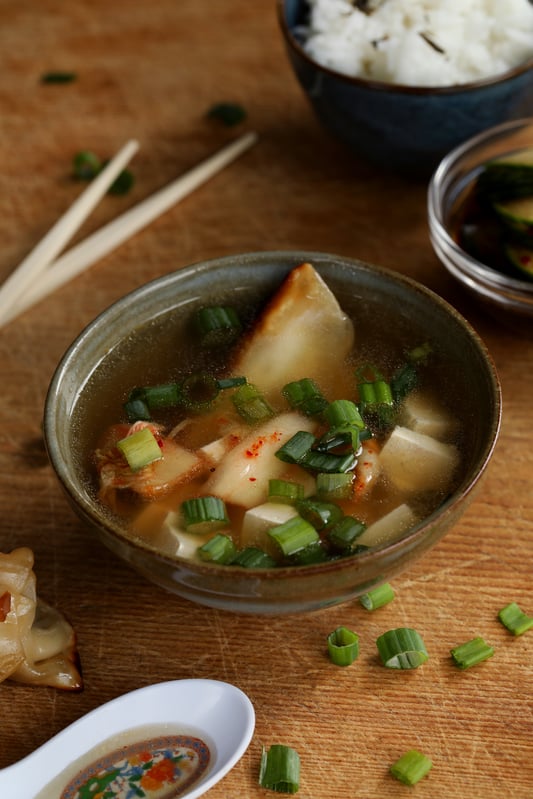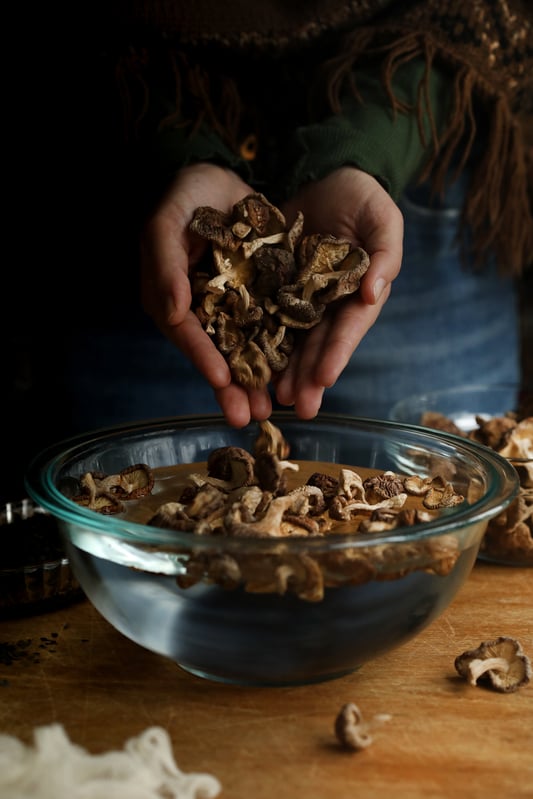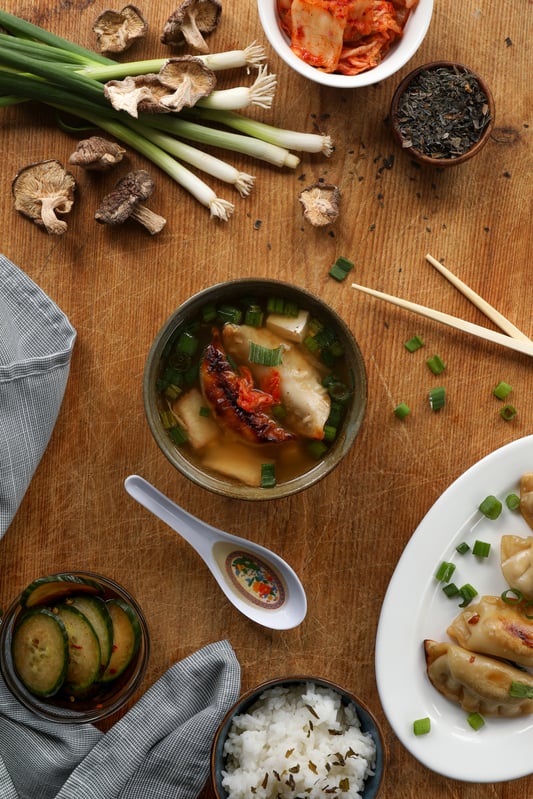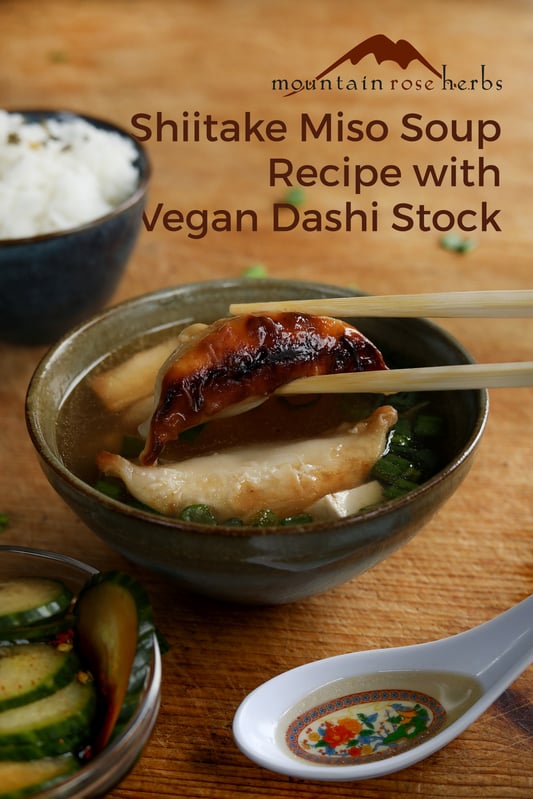Miso soup is an absolute must for me during the winter months. I’ll often make a large batch of it and warm some up for breakfast, cracking an egg into the umami-packed broth. It’s a common staple served at Japanese and Korean restaurants, often simply garnished with bits of tofu and chopped green onions. The two main components to miso soup are dashi and miso paste. Dashi is typically made with preserved fish and kombu, a flavorful and nutrient-rich seaweed. I decided to try making a vegan dashi stock using dried shiitakes along with my seaweed, and was pleasantly surprised.
Let’s talk about dashi: a simple broth made by soaking kelp (kombu) in water and bringing it just to a boil. Kombu contains a high amount of glutamic acids, which are the building blocks for the flavor umami. Paired with the flavors of dried fish (most commonly bonito), or in my case shiitake mushrooms, dashi provides the base for rich, aromatic soups, marinades, and even fry batter. Dashi is simple to make, requires very few ingredients, and is an excellent thing to have on hand when you want to punch up a recipe.
The second main component to miso soup is, of course, miso paste. If you’ve never shopped for miso before, you might be a little overwhelmed by the choices you’ll encounter at your local Asian grocer. Miso starts with koji, a fungus popular for fermenting foods in Japan, much like certain bacteria and mold are used to produce the flavors in cheese. Koji converts sugar into starches and releases glutamate, which is the basis for rich, umami flavor. Once koji is started (typically in rice, or rice mixed with soybeans), it is then added to soybeans, rice, or barley (or a combination) to ferment further into miso. Based on the ingredients and methods used, you’ll find a plethora of miso types in the store. I’ll break down the most common styles for you here.
Types of Miso Paste
White Miso – Light in color and made with a higher ratio of koji and rice to soybeans, white miso has a sweeter and milder flavor. It’s great for marinades and light sauces. Try mixing some with a little mayonnaise for a unique dipping sauce!
Yellow Miso – Fermented for longer than white miso, and containing a mixture of koji, soybeans, and barley, yellow miso is more acidic and saltier than white miso. It’s a very common variety in kitchens for its multitude of uses.
Red Miso – With the longest fermentation time, and the highest ratio of soybeans and barley, red miso can overwhelm a simple dish. It’s perfect for heartier soups or glazes.
Awase (mixed) Miso – One of the most versatile miso styles, awase (Ah-WAH-say) miso is a mixture of white and red miso. It’s perfect for a wide range of recipes with its delicate blend of sweet and salt.
Now that you have the building blocks for a restaurant-ready bowl of miso soup, let’s gather everything together and start simmering!
Shiitake Mushroom Vegan Dashi Stock
Makes about 2 1/2 quarts
Ingredients
- 1 1/2 oz. (about 3 cups) organic dried shiitake mushrooms
- 8 cups warm water
- 3 Tbsp. organic kombu flakes
Directions
- Place shiitake mushrooms in a large bowl and cover with water. Let steep for at least 1 hour.
- After steeping, remove mushrooms and squeeze out as much water as you can. Set mushrooms aside for soup (below) and reserve soaking liquid.
- Transfer soaking liquid to a pot and place on stovetop over medium high heat.
- Put the kombu flakes into a mesh strainer or cotton tea net, and drop into the liquid.
- Bring just to a simmer (don’t boil!). Simmer for about 2-3 minutes and taste frequently until desired flavor is reached (a good balance of earthiness and saltiness is what you’re looking for).
- Remove kombu, transfer liquid to a mason jar and refrigerate for up to 2 weeks.
Pro Tips
- You can also “cold brew” your dashi by adding shiitake mushrooms and kombu to warm water and allow to sit for up to 24 hours.
- Use leftover kombu flakes by adding to a pot of rice for flavoring. They give a nice salty flavor with added nutrients!
- Dashi is a staple in many Asian soup dishes, but also works well as a marinade for seafood or tofu.
GINGER MISO SOUP WITH VEGAN DASHI
Makes about 2 servings—you can easily scale up to make a larger batch
Ingredients
- 2 cups vegan dashi broth (see above)
- 1–2 cups water
- 2 Tbsp. miso paste (awase is my favorite)
- 1/2 Tbsp. fresh organic ginger root, peeled and grated
- 1/2 Tbsp. organic sesame oil
- 1 tsp. organic Atlantic wakame flakes
- Reconstituted organic shiitake mushrooms, from vegan dashi recipe (above), de-stemmed
- 1 block extra firm tofu, cubed
- Fresh green onion, chopped for garnish
Directions
- Combine dashi broth and water in a pot over medium heat.
- Once warmed through, remove about 1 cup of broth, put into a small bowl and add miso paste.
- Whisk with a fork until the miso has dissolved into the broth, add back into pot.
- Add ginger, sesame oil, wakame flakes, and reserved shiitakes.
- Allow soup to simmer, but don’t bring to a rolling boil.
- Once heated through, transfer to serving bowls, add tofu and green onion garnish.
Pro Tips
- Miso soup can be served with lots of different kinds of toppings. Try adding your favorite pot stickers (fried beforehand or dropped in to boil with the soup), udon or soba noodles, white rice, kimchi, or delicious leafy vegetables like bok choy, kale, or spinach.
Want to Try Another Vegan Take on a Traditional Soup?
Try This Vegan Pho Recipe with Mushrooms!
You May Also Like
3 Easy Shiitake Mushroom Recipes














